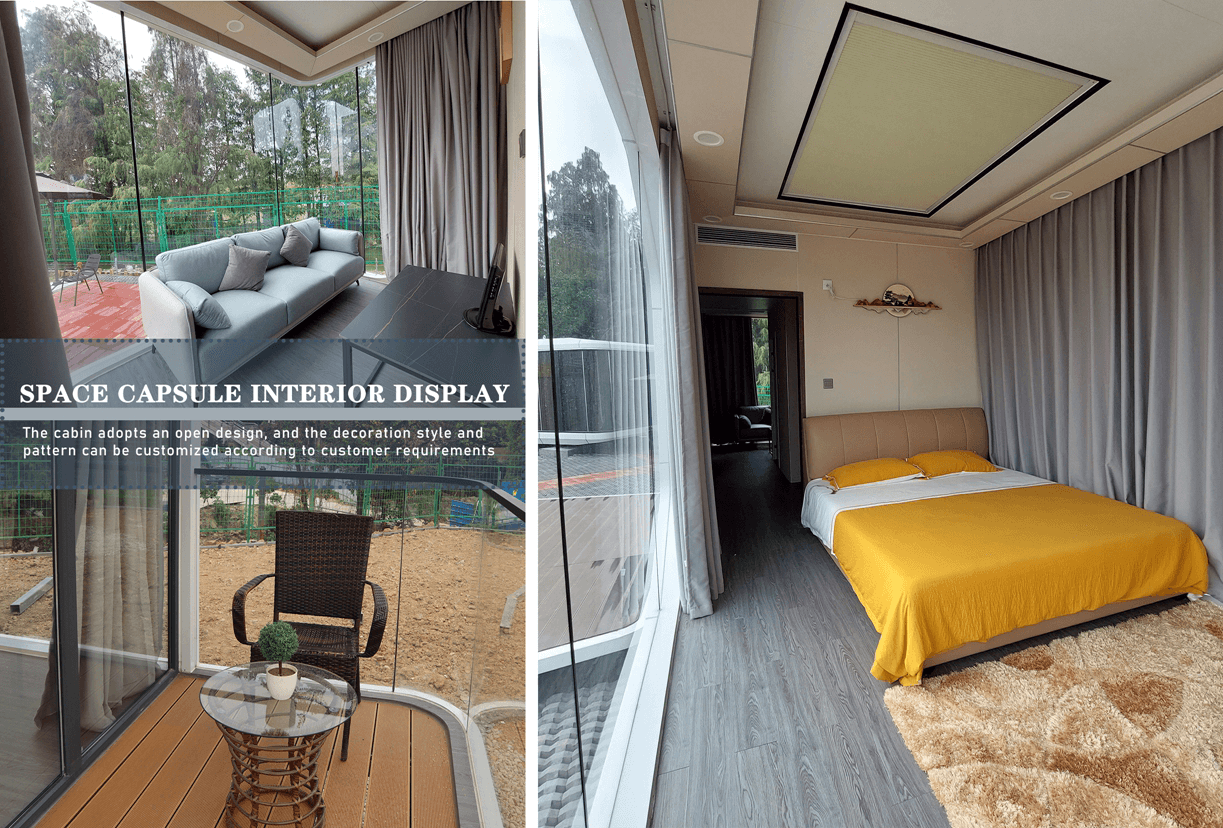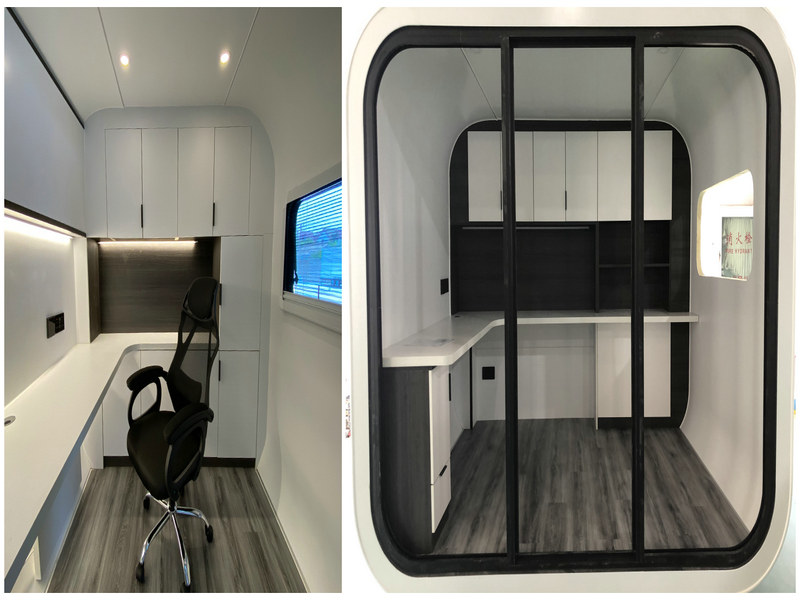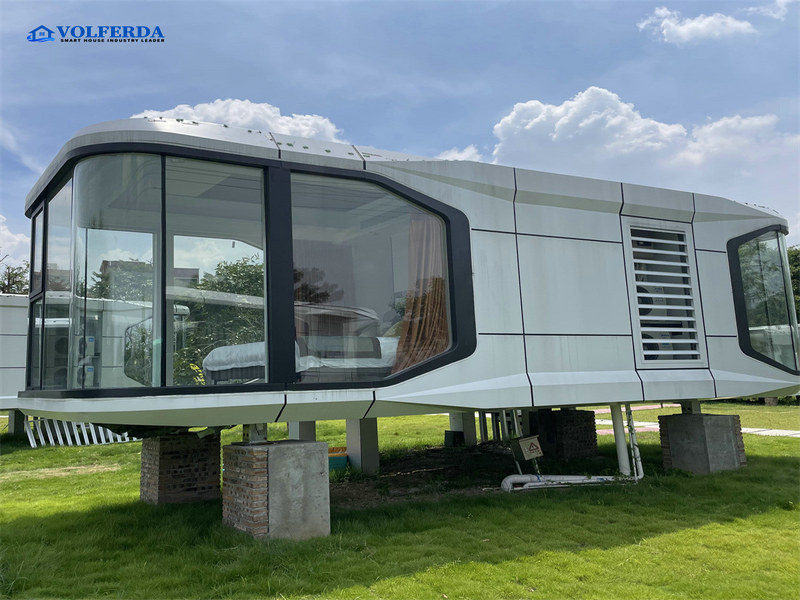South Africa Prefab Pod Residences with rainwater harvesting
Product Details:
Place of origin: China
Certification: CE, FCC
Model Number: Model E7 Capsule | Model E5 Capsule | Apple Cabin | Model J-20 Capsule | Model O5 Capsule | QQ Cabin
Payment and shipping terms:
Minimum order quantity: 1 unit
Packaging Details: Film wrapping, foam and wooden box
Delivery time: 4-6 weeks after payment
Payment terms: T/T in advance
|
Product Name
|
South Africa Prefab Pod Residences with rainwater harvesting |
|
Exterior Equipment
|
Galvanized steel frame; Fluorocarbon aluminum alloy shell; Insulated, waterproof and moisture-proof construction; Hollow tempered
glass windows; Hollow tempered laminated glass skylight; Stainless steel side-hinged entry door. |
|
Interior Equipment
|
Integrated modular ceiling &wall; Stone plastic composite floor; Privacy glass door for bathroom; Marble/tile floor for bathroom;
Washstand /washbasin /bathroom mirror; Toilet /faucet /shower /floor drain; Whole house lighting system; Whole house plumbing &electrical system; Blackout curtains; Air conditioner; Bar table; Entryway cabinet. |
|
Room Control Unit
|
Key card switch; Multiple scenario modes; Lights&curtains with intelligent integrated control; Intelligent voice control; Smart
lock. |
|
|
|
Send Inquiry



- 1
Rainwater Harvesting: Process, Types and Advantages EMBIBE
Website:www.embibe.com
Introduction:Rainwater harvesting is the process of saving rainwater. It is predicted that the next world war will be fought for water. Rainwater harvesting will help in preventing floods. This method will reduce the stress on our rivers and lakes. Rainwater harvesting will help aquatic life from getting polluted and depleted.
- 2
Everything you need to know about rainwater harvesting
Website:www.privateproperty.co.za
Introduction:Private Property Reporter Mar 5, 2021. Rainwater harvesting is described as a method of collecting rainwater for later use, as opposed to letting it run off into the drainage and sewer systems. It’s commonly used in rural areas and on farms but is fast-becoming an alternative method of using water and living more sustainably for people
- 3
Rainwater Harvesting South Africa Rainwater Storage Tanks
Website:smartsolartech.co.za
Introduction:Rainwater harvesting can be described as the collecting of water that originates from rainfall. Every time the rain falls, you have a chance to harvest it. If harvested and stored correctly, the water can be of great use on commercial, residential or agricultural properties in South Africa. The rainwater itself is normally relatively pure.
- 4
Rainwater Harvesting, Rainwater Harvesting Service in India
Website:dir.indiamart.com
Introduction:Ground Water Mineral Investigation Consultancy Centre Private Limited. Contact Supplier. Modular Rainwater Harvesting Service, Capacity: 2000 Liter. ₹ 6,500. Rbg Envirotech Solutions. Contact Supplier. With Material Ground recharge Rain Water Harvesting Service, in Pan India. ₹ 2.70 Lakh. Yash Borewell Engineers.
- 5
FOREST PODS Serenity Hills
Website:www.serenityhills.co.za
Introduction:Only 6 Available The pod sites will be located on an ocean-view slope, surrounded by coastal forest, with the building’s footprint adhering to the flow of the natural landscape, designed to minimally impact the natural site. Each solar-ready home will be built with rainwater harvesting and natural ventilation high up in the trees. Priced from
- 6
The ultimate solar-powered Ecomo pod home for off-grid living
Website:inhabitat.com
Introduction:Ecomo homes are modular and customizable, affording clients a great deal of flexibility. They are also prefabricated, which helps to reduce construction and shipping costs and material waste
- 7
You can now live off the grid in a modular home from R399k
Website:www.property24.com
Introduction:Venter says the the Umnyama Ikhaya motto is you dream it we build it”, and their modular home solutions are not limited to their 30sqm pod homes. They are a modular building company that can build and design anything from: A garage. A school. An apartment block. A luxury home. A library. A clinic. An office. A shopping centre.
- 8
Rainwater Harvesting -Process, Advantages and Disadvantages
Website:byjus.com
Introduction:Advantages of Rainwater Harvesting. The benefits of the rainwater harvesting system are listed below. Less cost. Helps in reducing the water bill. Decreases the demand for water. Reduces the need for imported water. Promotes both water and energy conservation. Improves the quality and quantity of groundwater.
- 9
Water-Efficient Technology Opportunity: Rainwater Harvesting
Website:www.energy.gov
Introduction:The Federal Energy Management Program (FEMP) identified rainwater harvesting systems as an alternative water technology that is relevant to federal facilities, is commercially available, and may offer an opportunity to offset freshwater use. This technology overview is intended to provide agencies with key information to deploy rainwater
- 10
Methods of Rainwater Harvesting -Components, Transport and
Website:theconstructor.org
Introduction:Methods of Rainwater Harvesting. 1. Surface Runoff Harvesting. In urban areas, rainwater flows away as surface runoff. This runoff can be caught and used for recharging aquifers by adopting appropriate methods. 2. Rooftop Rainwater Harvesting. It is a system of catching rainwater where it falls.
- 11
Rainwater Harvesting and Rural Livelihoods in Nepal Springer
Website:link.springer.com
Introduction:In this paper, we look at rainwater harvesting, which is being increasingly used in mountain agriculture in Nepal. Rainfed agriculture accounts for 65% of the total cultivable land area in Nepal. Since only 24% of the arable land is irrigated (mainly in the lowland Terai), crop productivity is significantly low in comparison to the rest of
- 12
Rainwater Harvesting: Advantages, Disadvantages, Uses and
Website:www.conserve-energy-future.com
Introduction:Rainwater harvesting is a critical source of clean water and increases the quantity of potable drinking water available. In developed countries, rainwater is often harvested as a supplemental water source rather than the main source. Still, the harvesting of rainwater can also decrease overall usage levels. 3.
- 13
Amazing Off-Grid Home Options for South Africans EcoPack
Website:ecopack.co.za
Introduction:Here are some ready-made options for you to choose from (prices include full inventory transport to site anywhere in South Africa). Options and price range: 30m 2 1 Bed 1 Bath Pod R 399 000. 30m 2 2 Bed 1 Bath Pod R 399 000. 60m 2 1 Bed 1 Bath Pod R 639 000. 60m 2 1 Bed 1 Bath Pod R 654 000. 90m 2 3 Bed 2 Bath Pod R 899 000.
- 14
Water management: rainwater harvesting and better storage
Website:www.farmersweekly.co.za
Introduction:Soil management, rainwater harvesting and proper storage of water all affect how efficiently farmers make use of water resources. While agriculture consumes about 75% of the rainfall in South Africa, 60% is utilised by natural vegetation, 12% by dryland crop production and 3% by irrigation. It is therefore imperative that this rain is used
- 15
Water in Agriculture: Rainwater Harvesting as a Sustainable
Website:www.elsenburg.com
Introduction:Ethiopia (Yosef Asmamaw, 2015) and Kenya. In South Africa, water-related legislation does not provide a clear legal framework and guidelines for the adoption of rainwater harvesting. The National Water Resource Strategy 2 (NWRS2) set out the strategic direction for water resource management in South Africa for the next 20 years.
- 16
Rainwater Harvesting Systems South Africa Aquadam
Website:www.aquadam.co.za
Introduction:The rainwater harvesting systems range from the simplest form like barrels to more elaborate structures with pumps, tanks, and purification systems. Non-potable water is used to irrigate landscaping, flush toilets, wash dishes and washing the laundry. The non-potable water can even be purified for human consumption.
- 17
Tiny off-the-grid pod to raise living conditions in South
Website:newatlas.com
Introduction:Johannesburg-based design studio, Architecture For A Change has recently completed the construction of an off-the-grid prefabricated unit located in Mamelodi, South-Africa. The tiny prototype is
- 18
Home Rainwater harvesting systems design and installation
Website:www.use-rainwater.com
Introduction:Rainwater Harvesting Specialists. An industry leading firm that specialize in the design, installation and commissioning of residential, commercial and industrial rainwater harvesting, water treatment and water backup water systems in Southern Africa. They delivered a creative and cost effective solution to one of my major clients.
- 19
BDI pod homes Estate Living
Website:www.estate-living.co.za
Introduction:Advertisement. This tiny home can be detached from its trailer and ‘planted’ on site and, when the need arises, be re-attached to its trailer and hitched to any large 4×4. The pod runs off solar power, uses water from its own rainwater harvesting tanks, and has a water-free composting loo. The 16 square metre open-plan ground floor
- 20
News: This luxury eco estate in South Africa wants to build
Website:www.l2b.co.za
Introduction:Serenity Hills plans to build six forest pod” homes within its 120-hectare eco-estate located in the coastal town of Margate on the KwaZulu Natal South Coast. The pod sites will be located on an ocean-view slope, surrounded by coastal forest, with the building’s footprint adhering to the flow of the natural landscape designed to
Related Products
 Miniature Space Houses accessories with rainwater harvesting
Rainwater harvesting suits people whose tiny house is permanently off-grid in a fixed location. This means that they can use space outside of the house for rainwater storage and not have to worry about moving it. Gutters and outside pipes can be installed too if you’re not moving the house anywhere. he CISTA rainwater harvesting system (which we just spotted on Kohler’s new H2OVisions website) is a dramatic, elegant and space-saving solution for the urban environment that conserves water
Miniature Space Houses accessories with rainwater harvesting
Rainwater harvesting suits people whose tiny house is permanently off-grid in a fixed location. This means that they can use space outside of the house for rainwater storage and not have to worry about moving it. Gutters and outside pipes can be installed too if you’re not moving the house anywhere. he CISTA rainwater harvesting system (which we just spotted on Kohler’s new H2OVisions website) is a dramatic, elegant and space-saving solution for the urban environment that conserves water
 Secure prefabricated tiny houses profits with rainwater harvesting
Parts Of A Tiny House Rainwater Collection System. Now that we've gotten all of that out of the way, we can move on to the parts of your rainwater collection system. Catchment Area The surface where the rainwater first touches before being collected. For most tiny house rainwater collection systems, this will be your roof. oduction:Prefabricated softwall cleanrooms certified up to ISO 5. Call for cleanroom pricing today! The revolutionary portable softwall cleanroom that's disrupting the industry.
Secure prefabricated tiny houses profits with rainwater harvesting
Parts Of A Tiny House Rainwater Collection System. Now that we've gotten all of that out of the way, we can move on to the parts of your rainwater collection system. Catchment Area The surface where the rainwater first touches before being collected. For most tiny house rainwater collection systems, this will be your roof. oduction:Prefabricated softwall cleanrooms certified up to ISO 5. Call for cleanroom pricing today! The revolutionary portable softwall cleanroom that's disrupting the industry.
 shipping container homes plans with rainwater harvesting blueprints
Southern Heritage Home Designs Traditional Southern House Plans. Browse hundreds of unique house plans you won't find anywhere else on the web on:Price: $40,000-$100,000. Photo: Backcountry container homes. Backcountry Containers builds custom shipping container homes out of a combination of stacked and adjoined 20 and 40-foot shipping container houses. A single 20-foot container home typically starts at $40,000.
shipping container homes plans with rainwater harvesting blueprints
Southern Heritage Home Designs Traditional Southern House Plans. Browse hundreds of unique house plans you won't find anywhere else on the web on:Price: $40,000-$100,000. Photo: Backcountry container homes. Backcountry Containers builds custom shipping container homes out of a combination of stacked and adjoined 20 and 40-foot shipping container houses. A single 20-foot container home typically starts at $40,000.
 South Africa Prefab Pod Residences with rainwater harvesting
Rainwater harvesting is the process of saving rainwater. It is predicted that the next world war will be fought for water. Rainwater harvesting will help in preventing floods. This method will reduce the stress on our rivers and lakes. Rainwater harvesting will help aquatic life from getting polluted and depleted. uction:Private Property Reporter Mar 5, 2021. Rainwater harvesting is described as a method of collecting rainwater for later use, as opposed to letting it run off into the drainage and sewer systems. It’s commonly used in rural areas and on farms but is fast-becoming an alternative method of using water and living more sustainably for people
South Africa Prefab Pod Residences with rainwater harvesting
Rainwater harvesting is the process of saving rainwater. It is predicted that the next world war will be fought for water. Rainwater harvesting will help in preventing floods. This method will reduce the stress on our rivers and lakes. Rainwater harvesting will help aquatic life from getting polluted and depleted. uction:Private Property Reporter Mar 5, 2021. Rainwater harvesting is described as a method of collecting rainwater for later use, as opposed to letting it run off into the drainage and sewer systems. It’s commonly used in rural areas and on farms but is fast-becoming an alternative method of using water and living more sustainably for people
 High-tech tiny houses series with rainwater harvesting in Ireland
In the Sonoran Desert, with just 11 inches of annual rainfall, he and his brother's family harvest about 100,000 gallons of rainwater a year on an eighth-acre urban lot and adjoining right-of-way. Over a million gallons more is annually harvested by Neighborhood Foresters-led efforts throughout the neighborhood. rvesting is an ancient practice currently used for flood and drought risk mitigation. It is a well-known solution with different levels of advanced technology associated with it. This study is aimed at reviewing the state of the art with regards to rainwater harvesting, treatment, and management. It focuses on the environmental and social benefits of rainwater harvesting and links
High-tech tiny houses series with rainwater harvesting in Ireland
In the Sonoran Desert, with just 11 inches of annual rainfall, he and his brother's family harvest about 100,000 gallons of rainwater a year on an eighth-acre urban lot and adjoining right-of-way. Over a million gallons more is annually harvested by Neighborhood Foresters-led efforts throughout the neighborhood. rvesting is an ancient practice currently used for flood and drought risk mitigation. It is a well-known solution with different levels of advanced technology associated with it. This study is aimed at reviewing the state of the art with regards to rainwater harvesting, treatment, and management. It focuses on the environmental and social benefits of rainwater harvesting and links
 Homemade Prefab Pod Residences resources with green roof
Ablenook Modular Dwellings. Launched as an architecture school project and later patented through the University of South Florida, AbleNook is a flat-pack kit home made from aircraft-grade aluminum framing and SIPs. The hurricane-resistant design can withstand 180-mph gusts of wind, and adjustable leg jacks enable it to adjust to uneven terrain. on">Introduction:Apt to be used as hotel room, a home or a cabin for events, the Drop XL is 30 sq meters in size and is manufactured for off-grid living. Easily transportable by road, the capsule is made of wood, glass and steel for least environmental impact. The attractive aspect of the pod is large bubble windows at the two ends.
Homemade Prefab Pod Residences resources with green roof
Ablenook Modular Dwellings. Launched as an architecture school project and later patented through the University of South Florida, AbleNook is a flat-pack kit home made from aircraft-grade aluminum framing and SIPs. The hurricane-resistant design can withstand 180-mph gusts of wind, and adjustable leg jacks enable it to adjust to uneven terrain. on">Introduction:Apt to be used as hotel room, a home or a cabin for events, the Drop XL is 30 sq meters in size and is manufactured for off-grid living. Easily transportable by road, the capsule is made of wood, glass and steel for least environmental impact. The attractive aspect of the pod is large bubble windows at the two ends.
 Deluxe tiny houses prefab benefits with rainwater harvesting in Kuwait
15 rainwater harvesting benefits. Rainwater harvesting is a great way of taking advantage of a freely available natural resource. Even the simplest rainwater collection systems can have many benefits for households. Here are 15 need-to-know advantages of collecting rainwater: 1. Rainwater collection is free (wherever it is allowed) ion">Introduction:We will also discuss the benefits of living in a prefab tiny house, how to live comfortably in a small space, and the legal requirements for owning one. Additionally, we will provide an in-depth review and comparison of the top 5 eco-friendly prefab tiny house models and brands, including detailed features, pros, and cons, as well as price
Deluxe tiny houses prefab benefits with rainwater harvesting in Kuwait
15 rainwater harvesting benefits. Rainwater harvesting is a great way of taking advantage of a freely available natural resource. Even the simplest rainwater collection systems can have many benefits for households. Here are 15 need-to-know advantages of collecting rainwater: 1. Rainwater collection is free (wherever it is allowed) ion">Introduction:We will also discuss the benefits of living in a prefab tiny house, how to live comfortably in a small space, and the legal requirements for owning one. Additionally, we will provide an in-depth review and comparison of the top 5 eco-friendly prefab tiny house models and brands, including detailed features, pros, and cons, as well as price
 Artistic Luxury Space Capsules details with rainwater harvesting in Kuwait
Hold the new downspout elbow up and rest it on the existing downspout, about 2 inches above the top of the rain barrel inlet. Use a sharpie to make a mark on your downspout, about 2 inches below thwestern Kuwait, it presents a unique new scene of greenery , bringing a refreshing touch to the hot summer in the desert. This precious greenery” in the desert is the rainwater collection system” construction of the Kuwait Mutra Project Department of Energy China Gezhouba Group.
Artistic Luxury Space Capsules details with rainwater harvesting in Kuwait
Hold the new downspout elbow up and rest it on the existing downspout, about 2 inches above the top of the rain barrel inlet. Use a sharpie to make a mark on your downspout, about 2 inches below thwestern Kuwait, it presents a unique new scene of greenery , bringing a refreshing touch to the hot summer in the desert. This precious greenery” in the desert is the rainwater collection system” construction of the Kuwait Mutra Project Department of Energy China Gezhouba Group.













